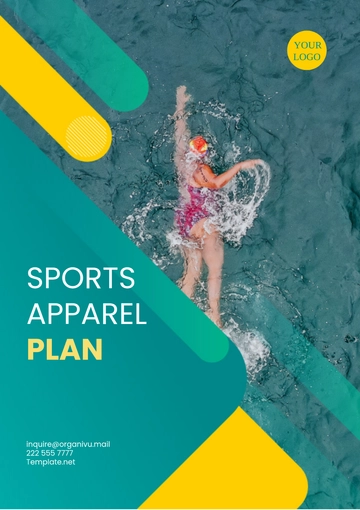Free Sports Apparel Plan Design

Prepared by: [Your Name]
Date: [Date]
I. Design Overview
The design overview describes the main design concepts and aesthetics of the sports apparel. The goal is to create visually appealing and functional athletic wear that meets the evolving needs of athletes and active individuals in 2050 and beyond.
A. Design Concepts
Modern and Sleek Designs
Emphasize minimalistic designs with streamlined silhouettes that enhance performance and mobility. Use advanced technology in fabrics to create garments that adapt to body movement.Incorporation of Brand Identity
Ensure that the designs reflect the brand’s ethos and values, focusing on innovation and sustainability. The designs should resonate with consumers’ growing desire for authenticity.Functional and Ergonomic Features
Integrate smart textiles that can monitor vital signs or adjust temperature based on environmental conditions, enhancing the athletic experience.Variety of Styles for Different Sports
Offer specialized lines for diverse sports, from traditional athletics to emerging sports in 2050, like drone racing or virtual reality athletics.
B. Aesthetic Considerations
Focus on color schemes, patterns, and brand icons that resonate with the target market and promote visual attraction. Consider collaborations with artists or designers to create unique, limited-edition collections that appeal to fashion-forward consumers.
II. Target Market
Identifying and understanding the target market is crucial for developing successful sports apparel.
A. Demographic Profile
Age: 18-45 years
Gender: Male and Female
Income Level: Middle to High
Location: Urban areas with a strong emphasis on health and fitness culture
B. Psychographic Profile
Active Lifestyle: Individuals engaged in sports, fitness classes, and outdoor activities.
Health-conscious: Focus on physical wellness, nutrition, and mental health.
Fashion-forward: Seek clothing that blends functionality with style, often influenced by social media trends.
III. Materials and Fabrics
Choosing the right materials and fabrics is essential to ensure the comfort, performance, and durability of sports apparel.
A. Key Fabric Choices
Polyester: Lightweight, moisture-wicking, and quick-drying, ideal for high-performance wear.
Nylon: Durable, abrasion-resistant, and often used in outdoor apparel.
Spandex: Offers stretch and flexibility, essential for activewear.
Cotton: Soft, breathable, and suitable for casual wear and leisure activities.
B. Fabric Technologies
Moisture-wicking Technology: Helps to keep the body dry by pulling moisture away from the skin.
Anti-microbial Treatment: Prevents odor and bacterial growth, ensuring freshness during extended wear.
UV Protection: Fabrics designed to shield against harmful UV rays, essential for outdoor sports.
IV. Production Plan
The production plan outlines the manufacturing process, including sourcing materials, production timeline, and quality control measures.
A. Sourcing Materials
Establish relationships with reliable suppliers for high-quality, innovative materials. Focus on sourcing from companies that prioritize sustainability and ethical practices.
B. Manufacturing Process
Stage | Description |
|---|---|
Prototyping | Develop initial samples using 3D printing technology to refine designs efficiently. |
Production | Mass production of finalized designs, utilizing automated processes to minimize waste. |
Quality Control | Implement advanced quality assurance systems using AI to ensure products meet high standards. |
V. Branding and Marketing Strategy
A strong branding and marketing strategy is essential to connect with the target audience and promote sports apparel.
A. Branding
Logo Design: Create a memorable and recognizable logo that reflects innovation and sustainability.
Brand Messaging: Develop a consistent brand voice that emphasizes health, fitness, and environmental consciousness.
Packaging: Design attractive, functional packaging that is biodegradable or recyclable.
B. Marketing
Social Media Campaigns: Leverage platforms like TikTok and Instagram for engaging content that showcases products in real-world scenarios.
Influencer Partnerships: Collaborate with fitness influencers and athletes to reach broader audiences and establish credibility.
Event Sponsorships: Sponsor sports events and competitions to increase brand visibility and connect with the active community.
Online and Offline Advertising: Utilize augmented reality (AR) advertisements that allow consumers to visualize products in a virtual environment before purchasing.
VI. Costing and Budget
Proper budgeting and cost management are crucial for the financial success of the sports apparel line.
A. Cost Estimation
Calculate the costs of materials, production, marketing, shipping, and other expenses, accounting for inflation and potential shifts in the global economy by 2050.
B. Budget Allocation
Distribute the budget across different areas such as design, production, marketing, and operations, ensuring flexibility to adapt to market trends.
VII. Sustainability Practices
Implementing sustainable practices helps in creating eco-friendly sports apparel and promotes a positive brand image.
A. Eco-friendly Materials
Use recycled and sustainable materials for production, such as recycled polyester and organic cotton, to reduce the environmental impact.
B. Ethical Manufacturing
Ensure fair labor practices and environmentally friendly manufacturing processes. Partner with factories that adhere to high ethical standards.
C. Waste Reduction
Minimize waste through efficient production processes and recycling initiatives, such as take-back programs for used apparel to encourage circular economy practices.
VIII. Conclusion
The Sports Apparel Plan Design is a comprehensive strategy that encompasses all aspects of designing, producing, and marketing sportswear in the evolving landscape of 2050 and beyond. By focusing on innovation, sustainability, and a deep understanding of the target market, this plan aims to establish a leading position in the competitive sports apparel industry while addressing the changing needs and values of consumers.
- 100% Customizable, free editor
- Access 1 Million+ Templates, photo’s & graphics
- Download or share as a template
- Click and replace photos, graphics, text, backgrounds
- Resize, crop, AI write & more
- Access advanced editor
Launch your sportswear business with the Sports Apparel Plan Design Template from Template.net. This customizable and editable template allows you to create a detailed plan covering every aspect of your business, from design to marketing. Tailor the template to fit your brand, with convenient editing features editable in our Ai Editor Tool for quick modifications and updates.
You may also like
- Finance Plan
- Construction Plan
- Sales Plan
- Development Plan
- Career Plan
- Budget Plan
- HR Plan
- Education Plan
- Transition Plan
- Work Plan
- Training Plan
- Communication Plan
- Operation Plan
- Health And Safety Plan
- Strategy Plan
- Professional Development Plan
- Advertising Plan
- Risk Management Plan
- Restaurant Plan
- School Plan
- Nursing Home Patient Care Plan
- Nursing Care Plan
- Plan Event
- Startup Plan
- Social Media Plan
- Staffing Plan
- Annual Plan
- Content Plan
- Payment Plan
- Implementation Plan
- Hotel Plan
- Workout Plan
- Accounting Plan
- Campaign Plan
- Essay Plan
- 30 60 90 Day Plan
- Research Plan
- Recruitment Plan
- 90 Day Plan
- Quarterly Plan
- Emergency Plan
- 5 Year Plan
- Gym Plan
- Personal Plan
- IT and Software Plan
- Treatment Plan
- Real Estate Plan
- Law Firm Plan
- Healthcare Plan
- Improvement Plan
- Media Plan
- 5 Year Business Plan
- Learning Plan
- Marketing Campaign Plan
- Travel Agency Plan
- Cleaning Services Plan
- Interior Design Plan
- Performance Plan
- PR Plan
- Birth Plan
- Life Plan
- SEO Plan
- Disaster Recovery Plan
- Continuity Plan
- Launch Plan
- Legal Plan
- Behavior Plan
- Performance Improvement Plan
- Salon Plan
- Security Plan
- Security Management Plan
- Employee Development Plan
- Quality Plan
- Service Improvement Plan
- Growth Plan
- Incident Response Plan
- Basketball Plan
- Emergency Action Plan
- Product Launch Plan
- Spa Plan
- Employee Training Plan
- Data Analysis Plan
- Employee Action Plan
- Territory Plan
- Audit Plan
- Classroom Plan
- Activity Plan
- Parenting Plan
- Care Plan
- Project Execution Plan
- Exercise Plan
- Internship Plan
- Software Development Plan
- Continuous Improvement Plan
- Leave Plan
- 90 Day Sales Plan
- Advertising Agency Plan
- Employee Transition Plan
- Smart Action Plan
- Workplace Safety Plan
- Behavior Change Plan
- Contingency Plan
- Continuity of Operations Plan
- Health Plan
- Quality Control Plan
- Self Plan
- Sports Development Plan
- Change Management Plan
- Ecommerce Plan
- Personal Financial Plan
- Process Improvement Plan
- 30-60-90 Day Sales Plan
- Crisis Management Plan
- Engagement Plan
- Execution Plan
- Pandemic Plan
- Quality Assurance Plan
- Service Continuity Plan
- Agile Project Plan
- Fundraising Plan
- Job Transition Plan
- Asset Maintenance Plan
- Maintenance Plan
- Software Test Plan
- Staff Training and Development Plan
- 3 Year Plan
- Brand Activation Plan
- Release Plan
- Resource Plan
- Risk Mitigation Plan
- Teacher Plan
- 30 60 90 Day Plan for New Manager
- Food Safety Plan
- Food Truck Plan
- Hiring Plan
- Quality Management Plan
- Wellness Plan
- Behavior Intervention Plan
- Bonus Plan
- Investment Plan
- Maternity Leave Plan
- Pandemic Response Plan
- Succession Planning
- Coaching Plan
- Configuration Management Plan
- Remote Work Plan
- Self Care Plan
- Teaching Plan
- 100-Day Plan
- HACCP Plan
- Student Plan
- Sustainability Plan
- 30 60 90 Day Plan for Interview
- Access Plan
- Site Specific Safety Plan

























